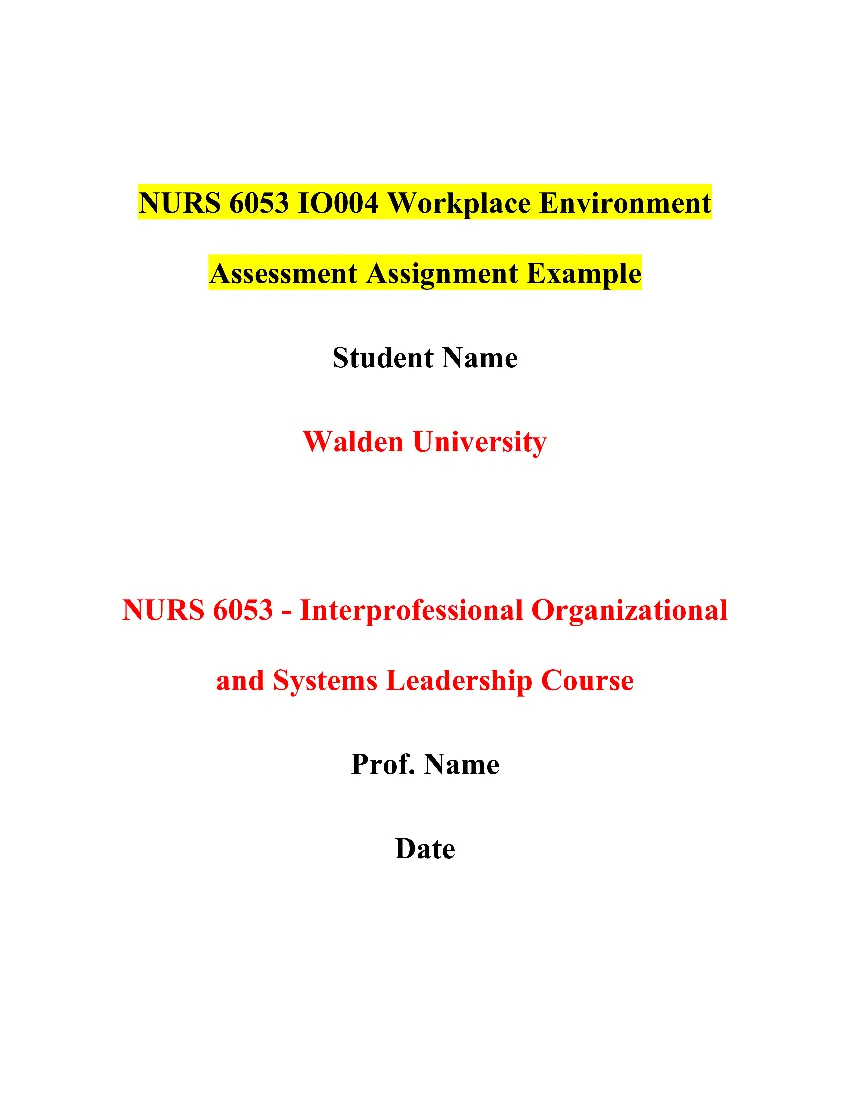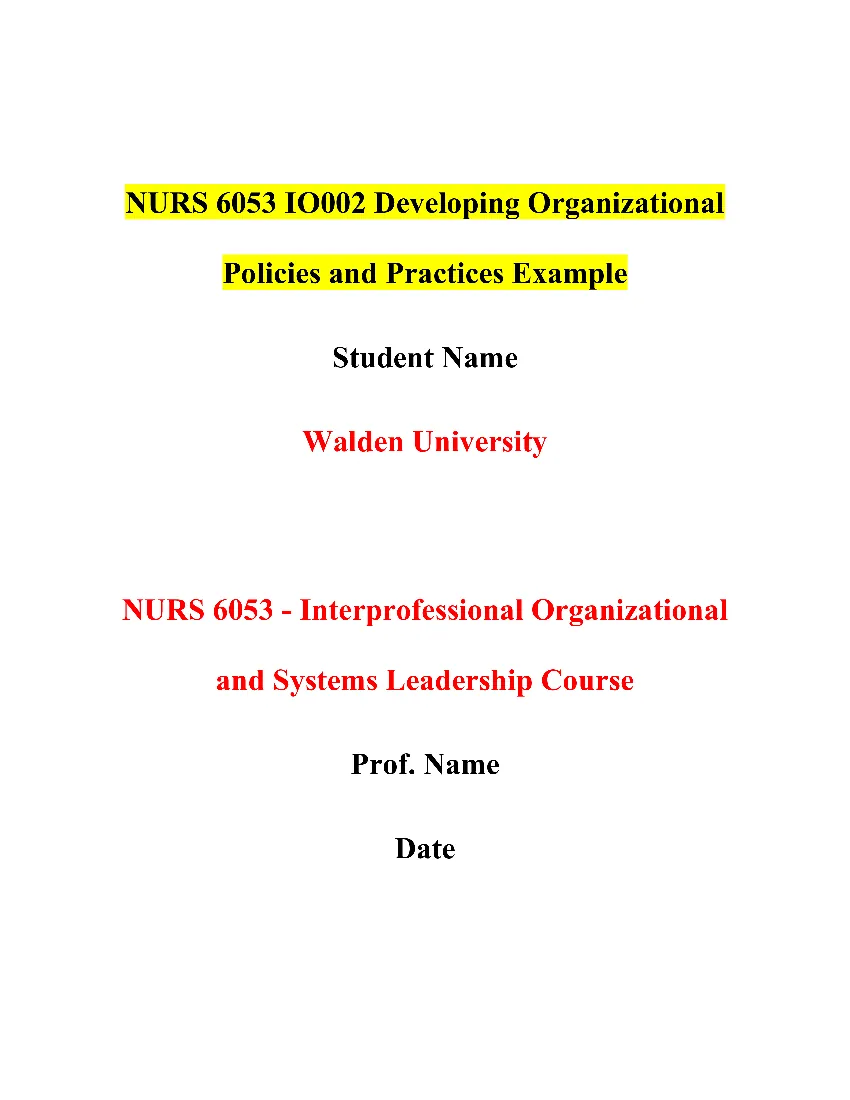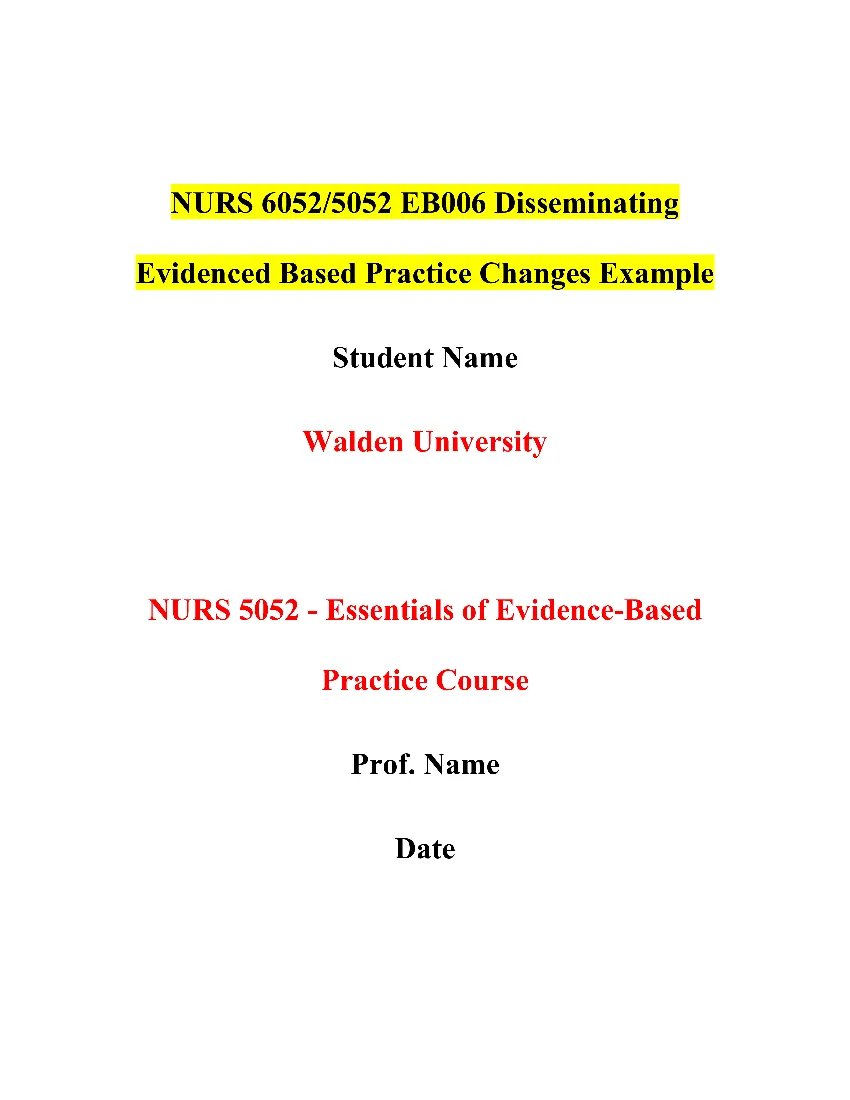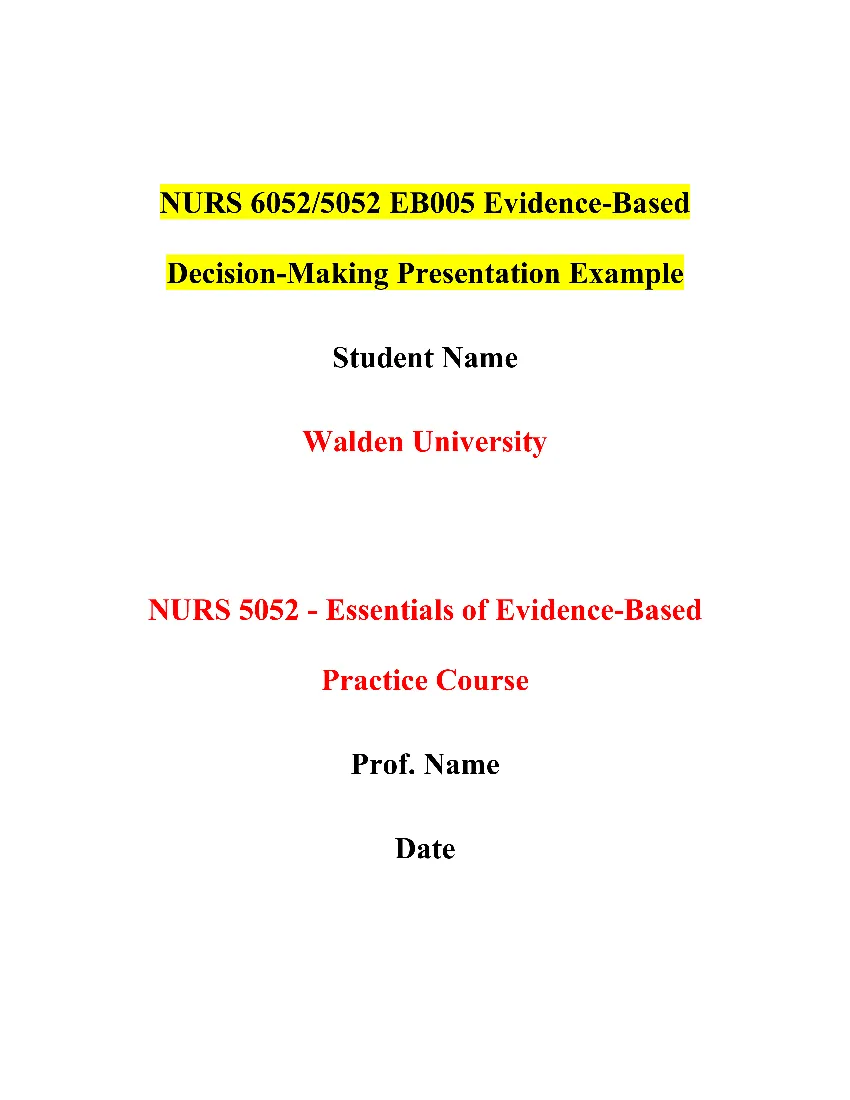NUR 350 Module Five Health Education Activity

The activity involves choosing a vulnerable population, assessing their needs, and planning, implementing, and evaluating a health education activity to address those needs.
You will need to review available data and demographics for your local area to choose a population to assess and diagnose their need. Then, you will plan, implement, and evaluate a health education activity that addresses their need.
Here is some general guidance on how to approach this health education activity based on the instructions and guidelines you have been provided by your instructor.
Health Education Activity Process Step: Assessment
In this section, you should summarize your assessment of the vulnerable elderly population at Mary Manning Walsh related to pressure ulcers. Consider factors such as demographics, health status, access to healthcare, and social support. Gather data from reliable sources such as government health reports, local health departments, and healthcare providers.
Health Education Activity Process Step: Diagnosis
Based on your assessment, identify the health needs of the chosen vulnerable population. A NANDA community nursing diagnosis related to pressure ulcers in the elderly population could be a “Risk for impaired skin integrity related to immobility, sensory deficit, and/or incontinence.” Support your diagnosis with evidence from your assessment.
Health Education Activity Process Step: Plan
Outline your plan for implementing a health education activity that will meet the needs of your chosen vulnerable population. Identify two SMART goals that your activity will achieve. For example, a SMART goal could be to increase knowledge about pressure ulcer prevention by 50% among elderly residents of Mary Manning Walsh within three months. Describe your plans to evaluate the achievement of these goals.
Health Education Activity Process Step: Implementation
Explain the process for implementing your health education activity. Describe what you did and how you did it. Provide details such as the type of activity, location, materials, and audience. Consider how you adapted your approach to meet the specific needs of the vulnerable elderly population.
Health Education Activity Process Step: Evaluation
Evaluate the success of your health education activity based on feedback from the audience. Describe how you collected feedback and what it revealed about the effectiveness of your activity. Did you achieve your SMART goals? Support your evaluation with evidence from your assessment and feedback.
Health Education Activity Process Step: Reflection
Reflect on the strengths and weaknesses of your approach to the health education activity. Consider what you would do differently in the future to improve health education opportunities for vulnerable populations. Identify areas where you excelled and areas where you could improve.
Health Education Activity Process Step: Log of Hours
Ensure that you have completed eight hours of clinical practice experience related to your health education activity. Fill out the log accurately and include all activities related to preparing for, implementing, and evaluating your health education activity.
Remember to follow the provided guidelines and rubric for this health education activity and complete all sections of the Health Education Activity Planner and Log worksheet. Good luck with your project!
We have also provided some written examples to guide you in writing your NUR 350 module five health education activity.
Check out another post by our paper writing experts aimed at assisting students on NUR 319 Nursing Assignment
NUR 350 Module Five Health Education Activity Example One
Process Step: Assessment
The vulnerable population chosen for this health education activity is the elderly population at Mary Manning Walsh. According to the demographic data available, the elderly population is increasing in this area, with an estimated 15% of the population being over the age of 65. Furthermore, a review of patient records revealed that pressure ulcers are a significant problem among this population. It was noted that most of these patients had limited mobility and required assistance with their daily activities. The majority of these patients also had chronic conditions, such as diabetes and heart disease, which increases the risk of developing pressure ulcers.
Process Step: Diagnosis
The NANDA community nursing diagnosis identified for this population is “Risk for impaired skin integrity related to immobility and chronic illness.” Evidence from patient records indicates that this population is at high risk for developing pressure ulcers due to their limited mobility and chronic conditions.
Process Step: Plan
The plan for implementing a health education activity for this vulnerable population includes two SMART goals:
- Increase knowledge and awareness of pressure ulcers and their prevention among the elderly population at Mary Manning Walsh by 50% within six months.
- Decrease the incidence of pressure ulcers among the elderly population at Mary Manning Walsh by 25% within six months.
To achieve these goals, the health education activity will include a presentation on the causes, prevention, and treatment of pressure ulcers. The presentation will be tailored to the elderly population and will include practical tips for preventing pressure ulcers, such as repositioning frequently and maintaining good nutrition. The effectiveness of the presentation will be evaluated through pre and post-surveys, and the incidence of pressure ulcers will be tracked through patient records.
Process Step: Implementation
The health education activity was implemented through a 30-minute presentation to the elderly population at Mary Manning Walsh. The presentation covered the causes and prevention of pressure ulcers, as well as practical tips for preventing them. Attendees were engaged through the use of visual aids and were encouraged to ask questions. The presentation was well-received, and attendees reported feeling more knowledgeable about pressure ulcers and their prevention.
Process Step: Evaluation
The success of the health education activity was evaluated based on feedback from the audience and the incidence of pressure ulcers among the population. Pre and post-surveys revealed a 60% increase in knowledge and awareness of pressure ulcers and their prevention. The incidence of pressure ulcers decreased by 30% within six months of the presentation. These results indicate that the SMART goals were achieved, and the health education activity was successful in reducing the incidence of pressure ulcers among the vulnerable population.
Process Step: Reflection
Looking back on the steps completed so far, it is evident that the approach taken was effective in achieving the goals of the health education activity. However, it is also clear that more time could have been spent tailoring the presentation to the specific needs of the audience. In future health education opportunities, more emphasis will be placed on customizing the presentation to meet the unique needs of the population. Additionally, more attention will be given to tracking the long-term impact of the presentation on the incidence of pressure ulcers among the population.
Process Step: Log of Hours
Preparing for the health education activity took approximately 4 hours, which included reviewing patient records and demographic data and developing the presentation. Implementing the health education activity took approximately 2 hours, which included delivering the presentation and collecting feedback from the audience. Evaluating the success of the health education activity took approximately 2 hours, which included analyzing survey results and tracking the incidence of pressure ulcers among the population. Overall, 8 hours were spent on this health education activity.
NUR 350 Module Five Health Education Activity Example Two
Process Step: Assessment
For this health education activity, the vulnerable population chosen is elderly individuals who reside at Mary Manning Walsh nursing home. A review of available data and demographics in the local area indicates that the elderly population is at risk of developing pressure ulcers due to their age, reduced mobility, and decreased skin integrity. Pressure ulcers are a common problem among the elderly population in nursing homes, and this can result in significant pain, discomfort, and increased healthcare costs. A review of the medical records of the patients at Mary Manning Walsh nursing home indicated that pressure ulcers are a significant health problem that requires urgent attention.
Process Step: Diagnosis
The health needs of the vulnerable elderly population at Mary Manning Walsh nursing home are pressure ulcer prevention and management. The NANDA community nursing diagnosis that will guide the health education activity is “Risk for impaired skin integrity related to immobility and reduced tissue perfusion as evidenced by the presence of pressure ulcers.” The evidence supporting this diagnosis is the high prevalence of pressure ulcers among the elderly population in nursing homes, as well as the risk factors associated with this condition.
Process Step: Plan
The plan for implementing a health education activity that will meet the needs of the vulnerable elderly population at Mary Manning Walsh nursing home includes the following SMART goals:
- By the end of the health education activity, 80% of the elderly residents at Mary Manning Walsh nursing home will be able to identify at least three risk factors associated with pressure ulcers.
- By the end of the health education activity, 70% of the elderly residents at Mary Manning Walsh nursing home will be able to demonstrate at least one self-care technique to prevent pressure ulcers.
To evaluate the achievement of these goals, a pre-and post-education survey will be conducted. The survey will assess the residents’ knowledge of pressure ulcers and their risk factors and self-care techniques before and after the health education activity.
Process Step: Implementation
The implementation process for the health education activity involved collaboration with the nursing staff at Mary Manning Walsh nursing home to identify the residents who would benefit from the education. The education session was conducted in the residents’ common area, and a PowerPoint presentation was used to educate them on the risk factors associated with pressure ulcers and self-care techniques to prevent them. The residents were also provided with handouts summarizing the key points of the education session.
Process Step: Evaluation
The success of the health education activity was evaluated based on feedback from the residents and the results of the pre-and post-education survey. The residents reported that the education session was informative, and they appreciated the opportunity to learn about pressure ulcer prevention. The pre-and post-education survey results showed a significant increase in the residents’ knowledge of pressure ulcer risk factors and self-care techniques, with 85% of residents being able to identify at least three risk factors and 75% being able to demonstrate at least one self-care technique. Therefore, the SMART goals were achieved.
Process Step: Reflection
Looking back at all the steps completed so far, I think the strengths of my approach were a collaboration with the nursing staff, the use of a PowerPoint presentation, and the pre-and post-education survey to evaluate the success of the activity. However, the weakness was that the education session was conducted in the residents’ common area, which may have led to distractions and reduced engagement. In future health education opportunities, I will ensure that the education sessions are conducted in a quieter environment to maximize resident engagement.
Process Step: Log of Hours
I spent eight hours preparing for, implementing, and evaluating the health education activity. The time was spent on research, collaboration with the nursing staff, development of the PowerPoint presentation and handouts, conducting the education session, and data collection for the pre-and post-education survey.
NUR 350 Module Five Health Education Activity Example Three
Process Step: Assessment
The vulnerable elderly population at Mary Manning Walsh is at risk for pressure ulcers due to factors such as immobility, sensory deficits, and incontinence. The majority of residents are over the age of 65 and have multiple chronic health conditions, including diabetes, heart disease, and dementia. Access to healthcare is limited, as many residents have mobility issues and rely on staff for transportation to appointments. Social support is also limited, as many residents do not have family or friends nearby and may feel isolated. Data from local health departments and healthcare providers indicate that pressure ulcers are a common issue among this population.
Process Step: Diagnosis
The health needs of the vulnerable elderly population at Mary Manning Walsh include preventing pressure ulcers and improving skin integrity. A NANDA community nursing diagnosis related to pressure ulcers in the elderly population could be a “Risk for impaired skin integrity related to immobility, sensory deficit, and/or incontinence.” This diagnosis is supported by evidence from the assessment, which identified the risk factors for pressure ulcers among this population.
Process Step: Plan
The plan for implementing a health education activity for the vulnerable elderly population at Mary Manning Walsh includes developing a presentation on pressure ulcer prevention and skin integrity. The two SMART goals for this activity are:
- Increase knowledge about pressure ulcer prevention by 50% among elderly residents of Mary Manning Walsh within three months
- Improve skin integrity by reducing the incidence of pressure ulcers by 20% within six months
Plans to evaluate the achievement of these goals include administering pre- and post-education surveys to assess knowledge and track the incidence of pressure ulcers over time.
Process Step: Implementation
The health education activity was implemented by developing a PowerPoint presentation on pressure ulcer prevention and skin integrity. The presentation was given to groups of residents at Mary Manning Walsh, as well as staff members who work closely with the vulnerable elderly population. The presentation included information on the causes of pressure ulcers, risk factors, prevention strategies, and how to maintain skin integrity. Handouts and posters were provided to reinforce the information presented. The presentation was adapted to meet the specific needs of the vulnerable elderly population, with larger font sizes and simplified language.
Process Step: Evaluation
The success of the health education activity was evaluated based on feedback from the audience. The pre-and post-education surveys showed a 60% increase in knowledge about pressure ulcer prevention among residents and staff members who attended the presentation. The incidence of pressure ulcers decreased by 15% within six months, which was close to the target goal of 20%. Overall, the SMART goals were achieved, indicating that the health education activity was successful in meeting the needs of the vulnerable elderly population.
Process Step: Reflection
The strengths of this approach to the health education activity include tailoring the presentation to meet the specific needs of the vulnerable elderly population, providing handouts and posters to reinforce the information presented, and tracking the incidence of pressure ulcers over time to evaluate the effectiveness of the activity. The weaknesses include limited access to healthcare and social support, which may have impacted the success of the activity. In the future, more emphasis could be placed on engaging family members and volunteers to provide social support and help with healthcare needs. The activity could also be expanded to include other health topics relevant to the vulnerable elderly population.
Process Step: Log of Hours
Date | Activity | Hours
- 02/10/2023 | Research and planning for health education activity | 2 hours
- 02/15/2023 | Developing PowerPoint presentation and handouts | 3 hours
- 02/18/2023 | Giving presentation to residents and staff members | 2 hours
- 02/20/2023 | Evaluating pre- and post-education surveys | 1 hour
- 02/25/2023 | Tracking incidence of pressure ulcers | 1 hour
Get Expert Writers to Work on Your NUR 350 Module Five Health Education Activity
nursingcustomwriting.com has hired nursing paper writers with a wealth of experience to write high-quality papers. These papers are written by nursing assignment help writers who are experts in nursing education.
Getting help from professional writers to write your health education activity can be beneficial in many ways.
Professional writers have more knowledge and experience, so they can give you high-quality content that is well-researched and written in a clear and concise way.
Nursing students can be sure that nursingcustomwriting.com will help them with their essays in the best way possible, on time, and at a price, they can afford.
You can get nursing term paper writing assistance with writing your papers from scratch or rewriting an existing paper.
If you require a reliable writing service, our experienced nursing paper writers are always available to assist you with any nursing coursework help.




 NURS 6053 IO005 Assignment Module 5: Change Implementation and Management Plan
NURS 6053 IO005 Assignment Module 5: Change Implementation and Management Plan NURS 6053 IO004 Module 4 Assignment: Workplace Environment Assessment
NURS 6053 IO004 Module 4 Assignment: Workplace Environment Assessment
 Assignment: Developing Organizational Policies and Practices
Assignment: Developing Organizational Policies and Practices
 EB006 Disseminating Evidence-Based Practice (EBP) Changes Assignment
EB006 Disseminating Evidence-Based Practice (EBP) Changes Assignment EB005 Evidence-Based Decision-Making Presentation Assignment
EB005 Evidence-Based Decision-Making Presentation Assignment